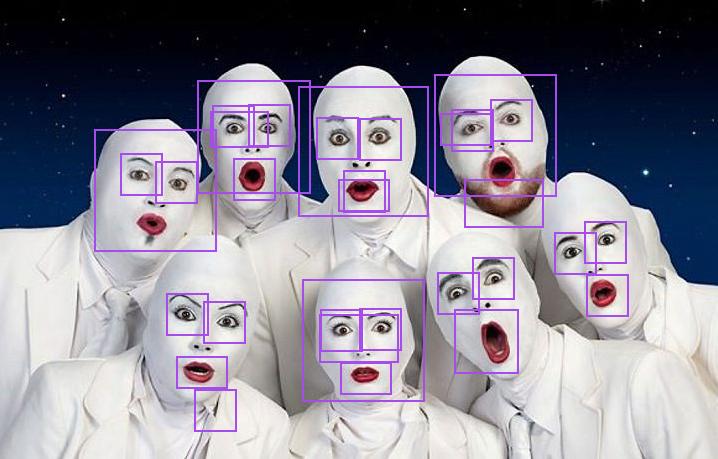
We started to learn tracking.js, which is a lightweight javascript library developed by Eduardo Lundgren. It allows you to do real-time face detection, color tracking and tagging friends' faces. In this tutorial we will see how we can detect faces, eyes and mouths from static images.
I have always been interested in face tagging, detection and face recognition technology in videos and pictures. Although I know that obtaining the logic and algorithms to develop facial recognition software or plug-ins is beyond my imagination. When I learned that a Javascript library could recognize smiles, eyes, and facial structures, I was inspired to write a tutorial. There are many libraries, which are either purely based on Javascript or based on the Java language.
Today, we start learning tracking.js, which is a lightweight javascript library developed by Eduardo Lundgren. It allows you to do real-time face detection, color tracking and tagging friends' faces. In this tutorial we will see how we can detect faces, eyes and mouths from static images.
At the end of the tutorial, you can see a tutorial that provides a working example with tips and tricks and more technical details.
First, we need to create a project, download the project from github and extract the build folder, and place the build folder according to your file and directory structure. In this tutorial, I used the following file and directory structure.
Folder structure
Project Folder
│
│ index.html
│
├───assets
│ face.jpg
│
└───js
│ tracking -min.js
│ tracking.js
│
└───data
eye-min.js
eye.js
face-min.js face-min.js face-min. js
using using using using using through using through out through out through out through out through out out through out ’'s' through out ’s' ’s' through through out's'''' through through’'s' back‐‐‐‐‐‐‐‐‐‐ exception's
Below is the html code of index.html. HTML code
<!doctype html>
<html>
<head>
<meta charset="utf-8">
<title>@tuts Face Detection Tutorial</title>
<script src="js/tracking-min.js"></script>
<script src="js/data/face-min.js"></script>
<script src="js/data/eye-min.js"></script>
<script src="js/data/mouth-min.js"></script>
<style>
.rect {
border: 2px solid #a64ceb;
left: -1000px;
position: absolute;
top: -1000px;
}
#img {
position: absolute;
top: 50%;
left: 50%;
margin: -173px 0 0 -300px;
}
</style>
</head>
<body>
<div class="imgContainer">
<img src="/static/imghw/default1.png" data-src="assets/face.jpg" class="lazy" id="img" / alt="How to implement face detection in JavaScript" >
</div>
</body>
</html>In order to achieve the goal, we need to modify the code in the header of the html file.
HTML code
<!doctype html>
<html>
<head>
<meta charset="utf-8">
<title>@tuts Face Detection Tutorial</title>
<script src="js/tracking-min.js"></script>
<script src="js/data/face-min.js"></script>
<script src="js/data/eye-min.js"></script>
<script src="js/data/mouth-min.js"></script>
<style>
.rect {
border: 2px solid #a64ceb;
left: -1000px;
position: absolute;
top: -1000px;
}
#img {
position: absolute;
top: 50%;
left: 50%;
margin: -173px 0 0 -300px;
}
</style>
// tracking code.
<script>
window.onload = function() {
var img = document.getElementById('img');
var tracker = new tracking.ObjectTracker(['face', 'eye', 'mouth']); // Based on parameter it will return an array.
tracker.setStepSize(1.7);
tracking.track('#img', tracker);
tracker.on('track', function(event) {
event.data.forEach(function(rect) {
draw(rect.x, rect.y, rect.width, rect.height);
});
});
function draw(x, y, w, h) {
var rect = document.createElement('div');
document.querySelector('.imgContainer').appendChild(rect);
rect.classList.add('rect');
rect.style.width = w + 'px';
rect.style.height = h + 'px';
rect.style.left = (img.offsetLeft + x) + 'px';
rect.style.top = (img.offsetTop + y) + 'px';
};
};
</script>
</head>
<body>
<div class="imgContainer">
<img src="/static/imghw/default1.png" data-src="assets/face.jpg" class="lazy" id="img" / alt="How to implement face detection in JavaScript" >
</div>
</body>
</html>  Result
Result
Code description.tracking.ObjectTracker() method classifies the objects you want to track, and it can accept an array as a parameter.
setStepSize( ) The step size of the specified block.
You may find that the results vary depending on the shape conditions There are differences, there are still areas that need improvement and improvement, and we also admit and sincerely agree with the development of this type of API.
Running example:
Running example with pictures.
More resources 8211; Javascript based facial recognition




